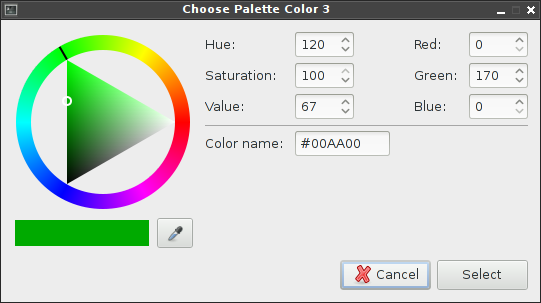Blog
Converting a GNOME Terminal colorscheme to X resources @ 24 Mar 2012
When I began using Linux regularly (nearly five years ago), I used both Ubuntu and Red Hat Enterprise Linux (RHEL) – both with the GNOME desktop environment.
Eventually, after moving to Arch, I developed a taste for lighter-weight applications, including my
terminal (I prefer rxvt-unicode).
The default terminal in GNOME is, as you might have guessed, GNOME Terminal. Issues with VTE aside, GNOME Terminal is great; and I still use it often on some machines. When I used Ubuntu, the default color scheme in GNOME Terminal was the "Linux console" theme (which, I imagine, is designed to mimic the default colors of a VT in Linux).
When I began using a terminal configured via X resources
(think .Xdefaults), I sought to replicate this color scheme – which I still use on
my personal machine to this day. Fortunately, once you understand the basic relationship between
GNOME Terminal's color preferences layout and the X resources color values, it's easy to map any
scheme.
Colors in X resources
I won't delve into the details of how X resources colors work in this post. For the purposes of a
basic tutorial, all you really need to know is that there are 16 "core" colors in X resources,
called color0, color1, etc., though color15.
To set these colors for use by all applications that understand X resources, you simply need to add
lines like the following to ~/.Xdefaults:
*color0: #000000
*color8: #555555
! ... (this is a comment)
*color7: #AAAAAA
*color15: #FFFFFF
(You'll notice that those aren't all in order. The reason isn't really important here; if you're
curious, search around for more information on colors in X resources/.Xdefaults.)
After your colors are set, you can load them by issuing the following command:
% xrdb -merge ~/.Xdefaults
The modified settings will then take effect when the affected application is restarted.
Chances are, your system is already configured to merge in your .Xdefaults on login, so you only
really need to worry about that command when you want to see your changes during the current session
(which, I imagine, is most of the time); but note that some applications will understand changes the
next time they're launched without the need to -merge yourself.
Get your colors from GNOME Terminal
The key to using colors from GNOME Terminal with X resources is to understand which colors in the preferences pane map to which color values.
To get to the color options in GNOME Terminal, open the "Edit" menu and then select "Profiles…"; select the profile whose colors you wish to copy, and then click the "Edit" button.
Now, go to the "Colors" tab. At the bottom, you'll see boxes that allow you to change each of the 16
colors available in GNOME Terminal:

The mapping is simple:
color0 color1 color2 color3 color4 color5 color6 color7
color8 color9 color10 color11 color12 color13 color14 color15
If you click a color in the grid, you'll get the following window:
 (Note that the window title gives the color number – the same as that in the above mapping table.)
(Note that the window title gives the color number – the same as that in the above mapping table.)
The value you need for your own .Xdefaults is the one in the "Color name" box.
Putting it all together
As you go through each of the colors in the GNOME Terminal preferences, you can add to and build
your color settings in your own ~/.Xdefaults.
As I mentioned earlier, I use the GNOME Terminal "Linux console" colors on my personal (Arch)
machine. Here are the colors, taken from my own .Xdefaults:
! colors
!! Taken from GNOME Terminal "Linux console" theme.
*color0: #000000
*color8: #555555
*color1: #AA0000
*color9: #FF5555
*color2: #00AA00
*color10: #55FF55
*color3: #AA5500
*color11: #FFFF55
*color4: #0000AA
*color12: #5555FF
*color5: #AA00AA
*color13: #FF55FF
*color6: #00AAAA
*color14: #55FFFF
*color7: #AAAAAA
*color15: #FFFFFF
I also prefer a white background, with black "normal" text. These two "special" colors are set as follows:
! bg/fg
*background: white
*foreground: black
(Note that some colors can, in fact, be set by name rather than hex #RRGGBB values.)